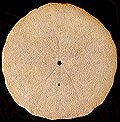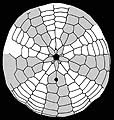The Echinoid Directory
Periarchus Conrad, 1866, p. 21
| Diagnostic Features |
|
|---|---|
| Distribution | Late Eocene of South East USA. |
| Name gender | masculine |
| Type | Sismondia alta Conrad, 1865, p. 74, by original designation. |
| Species Included |
|
| Classification and/or Status |
|
| Remarks |
|



